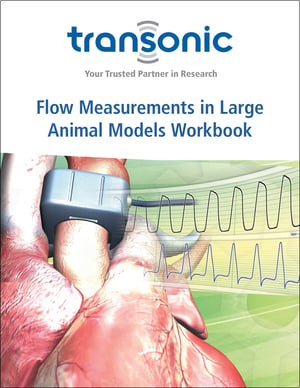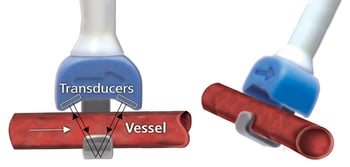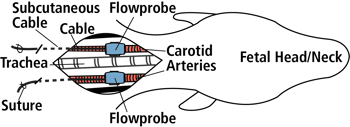Large Animal Blood Flow Studies and Their Challenges
Transonic has been working with life science researchers for almost 40-years. During that time a lot has changed in the field of animal research. Surgical approaches have been refined, anaesthesia and analgesia protocols have been optimized, and specialized surgical tools have been developed, just to name a few. One thing that remains the same; however, is the importance of quality educational tools. Over the years we have created hundreds of new resources to help simplify the education process, including a library of written and visual resources. A new resource we are excited about is the ‘Flow Measurements in Large Animals’ workbook, that I wish to highlight today.

This book should be seen as an inspirational companion piece to other available literature including the Pressure and Flow workbook, and many application notes and manuals freely available for you to download from our website.
What can you expect to find in the workbook? It contains a compilation of equipment information and large animal surgical models and protocols used to evaluate the blood flow measurements that we rely on today. In the book you will first find a review of Transonic’s Ultrasound transit-time technology theory and development. Also discussed in an earlier blog.

Using wide beam illumination, two transducers pass ultrasonic signals back and forth, alternately intersecting the flowing liquid in upstream and downstream directions. The Flowmeter derives an accurate measure of the “transit time” it takes for the wave of ultrasound to travel from one transducer to the other. The difference between the upstream and downstream integrated transit times is a measure of volume flow rather than velocity.
As a company that emphasizes education, we believe that explaining the technical details on how our equipment works, will help you to better understand the influence your surgical set-up may or may not have on the blood flow measurements.
Next in the workbook, we present the equipment components required for flow measurement. We will describe how to set up, test, and use them. Comprehensive quick start guides will walk you through the process as if we would be with you in the lab in person.
Finally, we will share a collection of surgical protocols. Our hope is that this workbook will provide useful information about flow measurements in different species and vessels, therefore expanding the possibilities for your current or future protocols.

Although the focus is on cardiovascular applications, the workbook does also contain surgically challenging protocol implanting flowprobes in fetal sheep and chronic lymph flow protocols; as Transonic’s perivascular flow probes are not only suitable for blood flow measurement but for lymph flow measurements as well.
We are proud to have always been directly involved in helping our users achieve the goals in any given experiment, but we understand the bulk of the work lies with the researcher. We hope this partnership between Transonic and customers continues to grow and that this growth can be reflected in future expanded versions of this book. For now, enjoy reading this new piece of supportive literature and feel free to reach out to our Application Specialists if one of the protocols sparks your interest.




